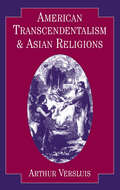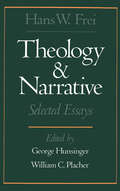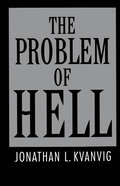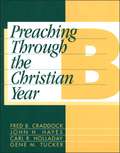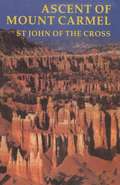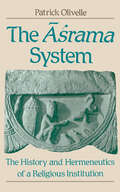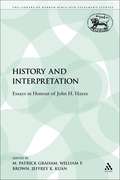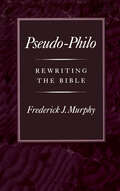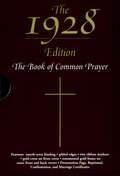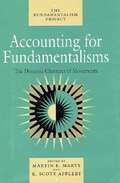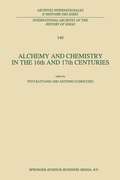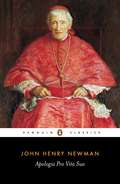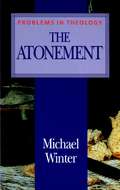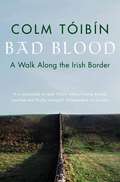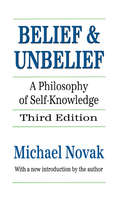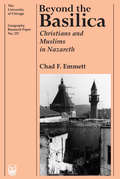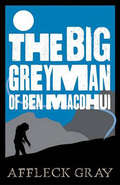- Table View
- List View
American Transcendentalism and Asian Religions (Religion in America)
by Arthur VersluisThe first major study since the 1930s of the relationship between American Transcendentalism and Asian religions, and the first comprehensive work to include post-Civil War Transcendentalists like Samuel Johnson, this book is encyclopedic in scope. Beginning with the inception of Transcendentalist Orientalism in Europe, Versluis covers the entire history of American Transcendentalism into the twentieth century, and the profound influence of Orientalism on the movement--including its analogues and influences in world religious dialogue. He examines what he calls "positive Orientalism," which recognizes the value and perennial truths in Asian religions and cultures, not only in the writings of major figures like Thoreau and Emerson, but also in contemporary popular magazines. Versluis's exploration of the impact of Transcendentalism on the twentieth-century study of comparative religions has ramifications for the study of religious history, comparative religion, literature, politics, history, and art history.
Theology and Narrative: Selected Essays
by the late Hans W. FreiHans W. Frei (1922-1988) was one of the most influential American theologians of his generation. Early in his career he drew attention to the importance of biblical narratives; he helped make Karl Barth once again a creative voice in contemporary theology; and he served as a model of what his colleague, George Lindbeck, has called "postliberal theology." This volume collects ten of Frei's lectures and essays, many of them never before published. Addressing audiences of theologians, biblical scholars, and literary critics, Frei explores the implications of his work for hermeneutics and Christology, and discusses Barth, Schleiermacher, and his own teacher, H. Richard Niebuhr. William Placher has provided an introduction to Frei's life and work, and the volume ends with an essay by George Hunsinger on Frei's significance for theology today. This collection provides an unrivaled introduction to Frei's work.
The Problem of Hell
by Jonathan L. KvanvigThe doctrine of hell presents the most intractable version of the problem of evil, for though it might be argued that ordinary pain and evil can somehow be compensated for by the course of future experience, the pain and suffering of hell leads nowhere. This work develops an understanding of hell that is common to a broad variety of religious perspectives, and argues that the usual understandings of hell are incapable of solving the problem of hell. Kvanvig first argues that the traditional understanding of hell found in Christianity suffers from moral and epistemological inadequacies. Historically, these shortcomings lead to alternatives to the traditional doctrine of hell, such as universalism, annihilationism, or the second chance doctrine. Kvanvig shows, however, that the typical alternatives to the traditional understanding are inadequate as well. He argues that both the traditional understanding and the typical alternatives fail to solve the problem of hell because they share the common flaw of being constructed on a retributive model of hell. Kvanvig then develops a philosophical account of hell which does not depend on a retributive model and argues that it is adequate on both philosophical and theological grounds.
Preaching Through the Christian Year: A Comprehensive Commentary on the Lectionary
by Fred B. Craddock Carl R. Holladay John H. Hayes Gene M. TuckerThis is the second volume in a comprehensive three-volume set of commentaries on all of the lectionary texts for Sunday reading (including the Psalms) and for special days in all communions, treating the readings for each year in a single volume. Preaching Through the Christian Year volumes are based on the newly revised The Common Lectionary (1992) together with other readings kept in the Episcopal, Lutheran, and Roman Catholic churches.The set will prove useful also for those who do not follow the lectionary, since each volume provides commentaries on a vast number of texts and includes a complete index of those texts."Simply put, the best commentary series on the best lectionary. An unusual blend of biblical and homiletical skills."--James F. White"This could be the Interpreter's Bible for our generation. The comments are succinct and satisfying on all counts."--David H. C. ReadThe authors of this important series teach at Candler School of Theology at Emory University, Atlanta, and are renowned scholars in their particular disciplines-preaching and Hebrew Bible and New Testament studies.
Ascent Of Mount Carmel
by R.H.J. Steuart E. Allison PeersThis work presents an outline of Christian perfection from the point at which the soul first seeks to rise from the earth and soar upward towards union with God. As a poet St John of the Cross was able, in the realm of mysticism, to push the frontiers of human xpression beyond any other writer.
The =Aśrama System: The History and Hermeneutics of a Religious Institution
by Patrick OlivelleThe lesser known and explored of the two pillars of Hinduism--=aśrama and var.na--=aśrama is the name given to a system of four distinct and legitimate ways of leading a religious life: as a celibate student, a married householder, a forest hermit, and a world renouncer. In this, the first full-length study of the =aśrama system, Olivelle uncovers its origin and traces its subsequent history. He examines in depth its relationship to other institutional and doctrinal aspects of the Brahmanical world and its position within Brahmanical theology, and assesses its significance within the history of Indian religion. Throughout, he argues that the =aśrama system is primarily a theological construct and that the system and its history should be carefully distinguished from the socio-religious institutions comprehended by the system and from their respective histories.
History and Interpretation: Essays in Honour of John H. Hayes (The Library of Hebrew Bible/Old Testament Studies)
by M. Patrick Graham William P. Brown Jeffrey K. KuanHistory and Interpretation is a collection of seventeen essays on the Old Testament and the history of ancient Israel and commemorates the sixtieth birthday of John H. Hayes, Professor of Old Testament at Candler School of Theology (Emory University). All the contributors were Hayes's doctoral students at Emory, and their essays cover a wide range of topics that reflect their teachers own scholarly interests-from historical geography and the history of ancient Israel to religion, theology, and the exegesis of individual texts. The methodologies employed are equally diverse: some focus on text-critical or form-critical issues, while others are essentially historical, rhetorical, or literary critical studies. Three essays are devoted to the Pentateuch, three to the Historical Books, four to the Prophets, and seven to the history of ancient Israel. A bibliography of Professor Hayes's publications is also included.
Pseudo-Philo: Rewriting the Bible
by Frederick J. MurphyThis is a literary and theological study of the Biblical Antiquities of Pseudo-Philo--a long, well-written reinterpretation of the Hebrew Bible written by a Palestinian Jew of the first century C.E. Using the methodologies of redaction and literary criticism, Murphy provides an analysis of the whole of the Biblical Antiquities. After a chapter-by-chapter analysis, Murphy addresses several topics more generally--major characters, major themes, and the historical context of the work. Full concordances to the Latin text are provided to assist future research on Pseudo-Philo. This book will prove an important resource for students of Jewish interpretation of the Bible at the end of the Second Temple period. It also sheds light on Jewish thought of the period regarding covenant, leadership in Israel, women in Israel, relations with Gentiles, divine providence, divine retribution, eschatology, and many other subjects. Furnishing a broad interpretive context for future work on the Biblical Antiquities, this study gives students of the Bible access to an important literary and religious product of first-century Judaism.
The 1928 Book of Common Prayer: Spiritual Formation Through The Book Of Common Prayer
by DavidThe 1928 Book of Common Prayer is a treasured resource for traditional Anglicans and others who appreciate the majesty of King James-style language. This classic edition features a Presentation section containing certificates for the rites of Baptism, Confirmation, and Marriage. The elegant burgundy hardcover binding is embossed with a simple gold cross, making it an ideal choice for both personal study and gift-giving. The 1928 Book of Common Prayer combines Oxford's reputation for quality construction and scholarship with a modest price - a beautiful prayer book and an excellent value.
Climax of the Covenant: Christ And The Law In Pauline Theology
by N. T. WrightA detailed examination of the passages central to the debate about Paul's christology and his view of Jewish Law. From meticulous exegesis makes some striking theological and historical conclusions.
Accounting for Fundamentalisms: The Dynamic Character of Movements (The Fundamentalism Project #4)
by Martin E. Marty R. Scott Appleby Nancy T. Ammerman Robert Eric Frykenberg Samuel C. Heilman James PiscatoriAccounting for Fundamentalisms features treatments of fundamentalist movements, groups that often make headlines but are rarely understood, as part of the multivolume Fundamentalism Project. This book remains a standard reference source for comprehending the dynamics of fundamentalist movements around the world. Surveying fundamentalist movements in Christianity, Judaism, Islam, Hinduism, Sikhism, and Buddhism, the contributors to Accounting for Fundamentalisms describe the organization of these movements, their leadership and recruiting techniques, and the ways in which their ideological programs and organizational structures shift over time in response to changing political and social environments.
Aging and God: Spiritual Pathways to Mental Health in Midlife and Later Years
by William M Clements Harold G KoenigThis important book examines the relationship between religion and mental health throughout the life cycle, with a special emphasis on later life. It asserts that successful aging is possible regardless of physical health or environmental circumstances, and that religious beliefs and behaviors may facilitate successful aging. Aging and God thoroughly examines the effects of religion and mental health on aging and provides a centralized resource of up-to-date references of research in the field. It focuses on recent findings, theoretical issues, and implications for clinical practice and contains ideas for further research. In Aging and God, you’ll also find information on project design that can help you develop grant applications and carry out studies.Aging and God is a helpful book for both mental health and religious professionals. It helps mental health specialists better understand the spiritual needs of older adults and the impact that religion can have on facilitating mental health. It also describes how religion can be utilized in clinical practice and integrated into psychotherapeutic approaches to older patients. The book brings religious professionals current knowledge of the major psychological problems that older adults face and how religion can be used to help alleviate these problems.Full of pertinent information, Aging and God addresses theoretical aspects of human development, focusing on cognitive, moral, and religious faith development examines situations and disorders of particular concern to older persons and looks at how religion can be used as a resource applies research findings to the problem of meeting the spiritual and mental health needs of elders with chronic or acute health problems provides an in-depth look at end-of-life issues such as physician-assisted suicideHospital and nursing home chaplains will find this book informative and encouraging, as will gerontologists, hospital administrators, and community clergy faced with increasingly older congregations. It gives mental health professionals new strategies to help improve the later years of older adults, and makes an excellent text for courses on religion, mental health, and aging. Middle-aged and older adults, as well as their families, will also find Aging and God enjoyable and inspiring as they attempt to grapple with the myriad adjustment and coping problems associated with aging.
Aging and God: Spiritual Pathways to Mental Health in Midlife and Later Years
by William M Clements Harold G KoenigThis important book examines the relationship between religion and mental health throughout the life cycle, with a special emphasis on later life. It asserts that successful aging is possible regardless of physical health or environmental circumstances, and that religious beliefs and behaviors may facilitate successful aging. Aging and God thoroughly examines the effects of religion and mental health on aging and provides a centralized resource of up-to-date references of research in the field. It focuses on recent findings, theoretical issues, and implications for clinical practice and contains ideas for further research. In Aging and God, you’ll also find information on project design that can help you develop grant applications and carry out studies.Aging and God is a helpful book for both mental health and religious professionals. It helps mental health specialists better understand the spiritual needs of older adults and the impact that religion can have on facilitating mental health. It also describes how religion can be utilized in clinical practice and integrated into psychotherapeutic approaches to older patients. The book brings religious professionals current knowledge of the major psychological problems that older adults face and how religion can be used to help alleviate these problems.Full of pertinent information, Aging and God addresses theoretical aspects of human development, focusing on cognitive, moral, and religious faith development examines situations and disorders of particular concern to older persons and looks at how religion can be used as a resource applies research findings to the problem of meeting the spiritual and mental health needs of elders with chronic or acute health problems provides an in-depth look at end-of-life issues such as physician-assisted suicideHospital and nursing home chaplains will find this book informative and encouraging, as will gerontologists, hospital administrators, and community clergy faced with increasingly older congregations. It gives mental health professionals new strategies to help improve the later years of older adults, and makes an excellent text for courses on religion, mental health, and aging. Middle-aged and older adults, as well as their families, will also find Aging and God enjoyable and inspiring as they attempt to grapple with the myriad adjustment and coping problems associated with aging.
Aging and the Religious Dimension (Non-ser.)
by Susan A. EisenhandlerAging and religion has been badly neglected in the field of Gerontology. This book, containing 13 chapters of original theory and research, is devoted to understanding the place that religion and spirituality hold in the lives of elderly persons. The authors, each experts in their own field, approach this issue from their backgrounds in the social sciences and the humanities.Overall this is a ground-breaking collection: It is one of the first attempts to seek to understand the role that religion plays in the lives of elderly persons. Based on their various multi-disciplinary perspectives, the authors make use of a variety of qualitative and quantitative methodologies as well as personal narrative and literature to grapple with this issue. Finally, the book is unique in that it addresses scholars and students, including the educated layman, rather than the professional alone.
Alchemy and Chemistry in the 16th and 17th Centuries (International Archives of the History of Ideas Archives internationales d'histoire des idées #140)
by Antonio Clericuzio Piyo RattansiThe present volume owes its ongm to a Colloquium on "Alchemy and Chemistry in the Sixteenth and Seventeenth Centuries", held at the Warburg Institute on 26th and 27th July 1989. The Colloquium focused on a number of selected themes during a closely defined chronological interval: on the relation of alchemy and chemistry to medicine, philosophy, religion, and to the corpuscular philosophy, in the sixteenth and seventeenth centuries. The relations between Medicina and alchemy in the Lullian treatises were examined in the opening paper by Michela Pereira, based on researches on unpublished manuscript sources in the period between the 14th and 17th centuries. It is several decades since the researches of R.F. Multhauf gave a prominent role to Johannes de Rupescissa in linking medicine and alchemy through the concept of a quinta essentia. Michela Pereira explores the significance of the Lullian tradition in this development and draws attention to the fact that the early Paracelsians had themselves recognized a family resemblance between the works of Paracelsus and Roger Bacon's scientia experimentalis and, indeed, a continuity with the Lullian tradition.
Apologia Pro Vita Sua: Being A Reply To A Pamphlet Entitled 'what, Then, Does Dr. Newman Mean?' (Cambridge Library Collection - Religion Ser.)
by Ian Ker John Newman Ian KerrJohn Henry Newman, one of the towering figures of the early Victorian Church of England, caused shock and outrage in equal measure when he announced his espousal of Roman Catholicism in 1845. His Apologia, written nearly twenty years later in response to a scurrilous public attack by Charles Kingsley, is a superbly crafted response to those who criticized his actions and questioned his motives, and traces his spiritual development since boyhood, his close involvement in the high church Tractarian Movement and his agonizing decision to reject the church he had been born into. Ostensibly an autobiography and a speech for the defence, the Apologia transcends self-justification to explore the very nature of Christianity and its place in the modern age.
The Atonement (Problems in Theology)
by Michael WinterWhat exactly is meant by atonement? The answer can be briefly summarised as the restoration of a reciprocal relationship of love between God the father and the human race. From this starting point, Winter goes on to address such questions as: why did Jesus have to die on the cross? and moves to posit answers to the questions that are central to the Christian mystery of faith, sin and atonement. In so doing, the wonder of the theology of grace is uncovered.Winter's contribution to the Problems in Theology series traces the history of attempts to reconcile and understand the problem of atonement posed in theology, before proposing a new understanding of the doctrine under debate.
Bad Blood
by Colm TóibínIn the summer after the Anglo-Irish Agreement, when tension was high in Northern Ireland, Colm Tóibín walked along the border from Derry to Newry. Bad Blood is a stark and evocative account of this journey through fear and hatred, and a report on ordinary life and the legacy of history in a bleak and desolate landscape.Tóibín describes the rituals – the marches, the funerals, the demonstrations – observed by both communities along the border, and listens to the stories which haunt both sides. With sympathy and insight Bad Blood captures the intimacy of life along one of the most contested strips of land in Western Europe.
The Baptists
by William H. BrackneyA brief, narrative survey of the Baptists in North America over the last three and a half centuries, from their roots in Europe to their present manifestations in contemporary America and the world. The six chapters are organized around five distinctives historically important to Baptists: the Bible, the Church, the ordinances/sacraments, voluntarism, and religious liberty. Concluding with a Chronology and extensive Bibliographic Essay, this is an ideal text for courses in Church History, North American Religious History, or American social and cultural history.
Belief and Unbelief: A Philosophy of Self-knowledge
by Michael NovakThis is perhaps the most widely read of Michael Novak's books. Belief and Unbelief attempts to push intelligence and articulation as far as possible into the stuff of what so many philosophers set aside as subjectivity. It is an impassioned critique of the idea of an unbridgeable gap between the emotive and the cognitive � and in its own way, represents a major thrust at positivist analysis.Written in a context of personal tragedy as well as intellectual search, the book is grounded in the belief that human experience is enclosed within a person to person relationship with the source of all things � sometimes in darkness, other tunes in aridity, but always in deep encounter with community and courage. It is written with a deep fidelity to classical Catholic thought as well as a sense of the writings of sociology, anthropology, and political theory�from Harold Lasswell to Friedrich von Hayek.This third edition includes Novak's brilliant 1961 article "God in the Colleges" from Harper's � a critique of the technification of university life that rules issues of love, death, and personal destiny out of bounds, and hence leaves aside the mysteries of contingency and risk, in favor of the certainties of research, production, and consumption. For such a "lost generation" Belief and Unbelief will remain of tremendous interest and impact.When the book first appeared thirty years ago, it was praised by naturalists and religious thinkers alike. Sidney Hook called it "a remarkable book, written with verve and distinction." James Collins termed it "a lively and valuable essay from which a reflective, religiously concerned reader can draw immense profit." And The Washington Post reviewer claimed that "Novak has written a rich, relentlessly honest introduction to the problem of belief. It is a deeply personal book, rigorous in argument and open ended in conclusions."
Belief and Unbelief: A Philosophy of Self-knowledge
by Michael NovakThis is perhaps the most widely read of Michael Novak's books. Belief and Unbelief attempts to push intelligence and articulation as far as possible into the stuff of what so many philosophers set aside as subjectivity. It is an impassioned critique of the idea of an unbridgeable gap between the emotive and the cognitive � and in its own way, represents a major thrust at positivist analysis.Written in a context of personal tragedy as well as intellectual search, the book is grounded in the belief that human experience is enclosed within a person to person relationship with the source of all things � sometimes in darkness, other tunes in aridity, but always in deep encounter with community and courage. It is written with a deep fidelity to classical Catholic thought as well as a sense of the writings of sociology, anthropology, and political theory�from Harold Lasswell to Friedrich von Hayek.This third edition includes Novak's brilliant 1961 article "God in the Colleges" from Harper's � a critique of the technification of university life that rules issues of love, death, and personal destiny out of bounds, and hence leaves aside the mysteries of contingency and risk, in favor of the certainties of research, production, and consumption. For such a "lost generation" Belief and Unbelief will remain of tremendous interest and impact.When the book first appeared thirty years ago, it was praised by naturalists and religious thinkers alike. Sidney Hook called it "a remarkable book, written with verve and distinction." James Collins termed it "a lively and valuable essay from which a reflective, religiously concerned reader can draw immense profit." And The Washington Post reviewer claimed that "Novak has written a rich, relentlessly honest introduction to the problem of belief. It is a deeply personal book, rigorous in argument and open ended in conclusions."
Beyond Legitimation: Essays on the Problem of Religious Knowledge (Library of Philosophy and Religion)
by Donald WiebeThe early essays in this volume proceed on the assumption that a compatibility system can be fashioned that will not only bring religious knowledge claims into harmony with scientific claims but will also show there to be a fundamental similarity of method in religious and scientific thinking. They are not, however, unambiguously successful. Consequently Professor Wiebe sets out in the succeeding essays to seek an understanding of the religion/science relationship that does not assume they must be compatible. That examination, in the final analysis, reveals a fundamental contradiction in the compatibility system building programme which more than suggests that religious belief (knowledge) is beyond legitimation.
Beyond the Basilica: Christians and Muslims in Nazareth (University of Chicago Geography Research Papers #237)
by Chad F. EmmettNazareth, the largest Arab city in Israel, is a surprising example of ethnic harmony in a region dominated by conflict. A recent trend toward integration of its historical Greek Orthodox, Roman Catholic, and Muslim quarters however, has disrupted the harmony. In Beyond the Basilica: Christians and Muslims in Nazareth, Chad F. Emmett provides penetrating analysis of the complex relationship between the structure of Nazareth’s quarters and the relations between its ethnic communities. Emmett describes both the positive and negative effects of Nazareth’s residential patterns. He shows that the addition of new and ethnically mixed quarters has promoted mixed schools, joint holiday celebrations, a common political culture, and social networks that cross ethnic boundaries. But he also finds that tensions exist among Christian groups and between Muslims and Christians in regard to intersectarian marriages, religious conversion, attempts to establish a joint Christian cemetery, and the emergence of a local Islamic party. Extensive interviews with leaders of religious groups, political parties, and residents reveal the way in which members of each ethnic community perceive one another. A survey of 300 families gives a wealth of details about the make-up of Nazareth’s population, including residential histories, religion, level of religious conviction, friendship and shopping patterns, and much more. Fourteen maps trace changes in the distribution of religious groups and political affiliation in Nazareth from the mid-nineteenth century to the present. Beyond the Basilica will interest cultural geographers, historians, demographers, political scientists, and anyone who would like to learn more about an ethnically divided community in the residents cooperate more than they fight.
Beyond the Basilica: Christians and Muslims in Nazareth (University of Chicago Geography Research Papers #237)
by Chad F. EmmettNazareth, the largest Arab city in Israel, is a surprising example of ethnic harmony in a region dominated by conflict. A recent trend toward integration of its historical Greek Orthodox, Roman Catholic, and Muslim quarters however, has disrupted the harmony. In Beyond the Basilica: Christians and Muslims in Nazareth, Chad F. Emmett provides penetrating analysis of the complex relationship between the structure of Nazareth’s quarters and the relations between its ethnic communities. Emmett describes both the positive and negative effects of Nazareth’s residential patterns. He shows that the addition of new and ethnically mixed quarters has promoted mixed schools, joint holiday celebrations, a common political culture, and social networks that cross ethnic boundaries. But he also finds that tensions exist among Christian groups and between Muslims and Christians in regard to intersectarian marriages, religious conversion, attempts to establish a joint Christian cemetery, and the emergence of a local Islamic party. Extensive interviews with leaders of religious groups, political parties, and residents reveal the way in which members of each ethnic community perceive one another. A survey of 300 families gives a wealth of details about the make-up of Nazareth’s population, including residential histories, religion, level of religious conviction, friendship and shopping patterns, and much more. Fourteen maps trace changes in the distribution of religious groups and political affiliation in Nazareth from the mid-nineteenth century to the present. Beyond the Basilica will interest cultural geographers, historians, demographers, political scientists, and anyone who would like to learn more about an ethnically divided community in the residents cooperate more than they fight.
The Big Grey Man of Ben Macdhui
by Affleck GrayIn an acclaimed account of the terrifying figure said to haunt the desolate passes and summit of Britain's second highest mountain, this book takes on one of Scotland's most chilling unsolved mysteries. Throughout the years, countless climbers have either seen or sensed the presence of some extraordinary being in the misty wilderness of Ben MacDhui. This book explores the evidence and also looks at similar stories from around the world to try and make sense of this bizarre phenomenon.
